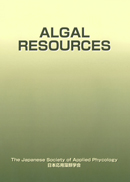巻号一覧

4 巻 (2011)
- 2 号 p. 55-
- 1 号 p. 1-
4 巻, 1 号
選択された号の論文の3件中1~3を表示しています
- |<
- <
- 1
- >
- >|
-
ドミトリー ガラニン, 四ツ倉 典滋, 川井 唯史2011 年4 巻1 号 p. 1-7
発行日: 2011年
公開日: 2021/06/03
ジャーナル フリーThe laminariaceous species Saccharina sculpera has been known to distribute in southwestern Hokkaido, Japan and in south Sakhalin, Russia. However, the previous information of its distribution in Sakhalin were based on old literatures, so we conducted a survey in June 2008 to make clear the present distribution of S. sculpera in south Sakhalin. We recognized populations of S. sculpera around the edge of the Krilion Peninsula where it grew at the mean depth of 10.7 m, but could not find around Kholmsk where S. sculpera distribution was reported in literatures during 1960's. Disappearance of its populations around Kholmsk in the past 50 years awakes us to the necessity of conservation on existing natural resources. The high genetic homology was confirmed by sequencing comparison on ITSs and RuBisCo spacer between plants sampled in the present study and S. sculpera sampled at Hakodate, Hokkaido, so it was proved that the plants in south Sakhalin were surely S. sculpera.抄録全体を表示PDF形式でダウンロード (1388K) -
馬 家海, 許 璞, 陸 勤勤2011 年4 巻1 号 p. 9-14
発行日: 2011年
公開日: 2021/06/03
ジャーナル フリーThe current situation of seeding, farming, production, processing of Porphyra yezoensis in China was shown in this paper involving to aspects such as the historical records of nori in China, fine strain selective breeding of P. yezoensis, separation and proliferation, cultivation engineering, research of the prevention of primary diseases and the relevant methods and techniques, first and second processing technique, and the quality analysis etc. Culture technique of P. yezoensis turns from manual to semiautomatic and to automatic, and achieved localization in some aspects of techniques. Great progress has been made in many fields such as breeding selection, seedling management, diseases control, application and popularization of short-term cold storage technology, and the quality control. The technique of separation and proliferation of conchocelis has been mastered as well. The farming area and export-volume of P. yezoensis and P. haitanensis in China are in the front row in the world that reveals vast potential for future development. But we also have some open questions as follows: 1. Select fine varieties and strain of Porphyra yezoensis; 2. Diseases occur frequently, the per unit area yield is difficult to increase; 3. Tideland reclamation increase for development of economy, then the cultivation sea area moves to open seas, lead to cost increase; Prospect of Nori industry in China: 1. The Chinese nori enterprises which integrate seeding, farming, processing, into one system, has great development potential; 2. Quantity demand of nori in the world market increases, result in rise of the laver's unit price, and the nori industry has vast potential for future development; 3. Believe the Chinese nori industry will obtain a great future as Japanese and South Korean抄録全体を表示PDF形式でダウンロード (1031K) -
大房 剛2011 年4 巻1 号 p. 15-21
発行日: 2011年
公開日: 2021/06/03
ジャーナル フリーFrom October 2008 to April 2009, the domestic production of Nori, Porphyra spp, amounted 9,106 million of sheets in Japan, while only 402 million sheets were imported from other countries. That is, 95% of Nori demanded in Japan, has been produced domestically. On the contrary, the import ratio of other seaweed, such as Wakame, Undaria pinnatifida, and Hijiki, Sargassum fusiforme has been quite high. Japan imported over 80% of its annual Wakame demand and approximately 90% of its annual Hijiki from Korea and China. Recently, however, in Japan many problems have been occurring in the edible seaweed industries field in terms of the price which has been kept lower, a skewed age composition of fishermen which is mostly consisted of the aged, and decreasing number of the fishermen. In regard to Wakame and Hijiki, how to maintain the current import volume must be a key issue. It is, therefore, very important to collect the information about cultivating condition of Wakame and Hijiki in Korea and China.抄録全体を表示PDF形式でダウンロード (1153K)
- |<
- <
- 1
- >
- >|